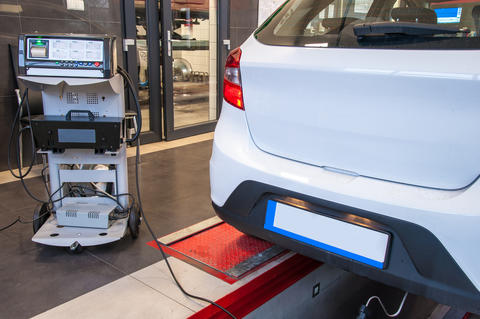Summary
The American Industry/Government Emissions Research (AIGER) Consortium is working to facilitate the automobile industry meeting more stringent 2003 Federal Tier II and California LEV II emission regulations to be implemented in 2010. NIST participates in AIGER as a stakeholder and receives input from AIGER's Standards Committee regarding requirements for new Standard Reference Materials (SRMs). AIGER members include: U.S. Environmental Protection Agency (EPA) Fuel and Emission Lab, California Air Resources Board, General Motors Powertrain, Ford Motor Company/VEE, and Daimler-Chrysler.
Description

NIST currently supports AIGER members by maintaining reasonable inventories of required gas SRMs that consist of dilute mixtures of key pollutants such as carbon dioxide, carbon monoxide, hydrocarbons, and nitric oxide. Newer vehicles produce lower levels of these pollutants because their engines employ fuel injection with air-to-fuel ratios optimized by an on-board computer and emissions reduced by efficient catalytic converters. During testing the tailpipe exhaust levels are diluted with clean air and collected using constant volume sampling bags or new mini-diluter technology. AIGER stakeholders have identified the need for gas standards with significantly lower concentrations of carbon monoxide, carbon dioxide, hydrocarbons, and nitric oxide.
NIST has responded to AIGER needs by developing four new SRMs with significantly lower concentrations of carbon dioxide, nitric oxide, and propane. They are:
SRM 2737 (500.0 ± 7.5) nmol/mol nitric oxide in nitrogen
SRM 2765 (100.0 ± 0.6) nmol/mol propane in air
SRM 2617 (500.0 ± 1.0) µmol/mol carbon dioxide in nitrogen
Nitric oxide and propane are precursors to smog formation. The new SRMs allow lower levels of these precursors to be monitored. It is estimated that when the regulations are fully implemented in 2010, smog-forming emissions in the Los Angeles area will be reduced by 57 tons per day. SRM 2617 is a high-accuracy carbon dioxide standard that will be used to measure fuel economy.
Research to minimize cylinder wall off-gassing of NO over time will be studied.
Major Accomplishments
- Nitric Oxide SRM 2737 (500 nmol/mol) has been prepared and certified.
- Propane SRM 2765 at 100 nmol/mol has been prepared and certified.
- Carbon Dioxide SRM 2619 at 500 µmol/mol has been prepared and certified with an expanded uncertainty of 0.2 µmol/mol.
Associated Publications
1. Rhoderick, G. C., Cecelski, C. E., Miller, W. R., Worton, D. R., Moreno, S., Brewer, P. J., Viallon, J., Idrees, F., Moussay, P., Kim, Y. D., Kim, D., Lee, S., Baldan, A., and Li, J., "Stability of gaseous volatile organic compounds contained in gas cylinders with different internal wall treatments," Elementa-Science of the Anthropocene, 7, (2019).
2. Rhoderick, G. C., Kelley, M. E., Miller, W. R., Norris, J. E., Carney, J., Gameson, L., Cecelsld, C. E., Harris, K. J., Goodman, C. A., Srivastava, A., and Hodges, J. T., "NIST Standards for Measurement, Instrument Calibration, and Quantification of Gaseous Atmospheric Compounds," Analytical Chemistry, 90, 4711-4718 (2018).
3. Baumgardner, D., Popovicheva, O., Allan, J., Bernardoni, V., Cao, J., Cavalli, F., Cozic, J., Diapouli, E., Eleftheriadis, K., Genberg, P. J., Gonzalez, C., Gysel, M., John, A., Kirchstetter, T. W., Kuhlbusch, T. A. J., Laborde, M., Lack, D., Muller, T., Niessner, R., Petzold, A., Piazzalunga, A., Putaud, J. P., Schwarz, J., Sheridan, P., Subramanian, R., Swietlicki, E., Valli, G., Vecchi, R., and Viana, M., "Soot reference materials for instrument calibration and intercomparisons: a workshop summary with recommendations," Atmospheric Measurement Techniques, 5, 1869-1887 (2012).

